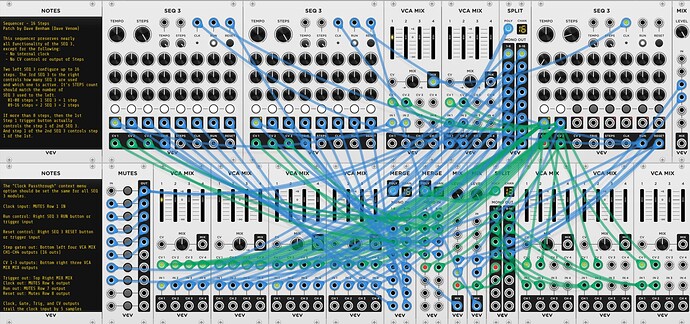Sequencers
The Fundamental SEQ 3 sequencer is very capable, with 3 independent CV output channels per step, plus step gates, and configurable step triggers or clock gates. With a bit of work it is possible to chain multiple SEQ 3 together and preserve almost all the functionality of the SEQ 3.
Each SEQ 3 you add can contribute up to 8 steps, plus one extra SEQ 3 is required to keep track of and control which of the other SEQ 3 is active. With this general design, it is possible to combine up to 4 SEQ 3 for a total of 32 steps relatively easily and efficiently. Going beyond that becomes less efficient due to limited options for mixers.
So the master SEQ 3 steps is configured to match the number of SEQ 3 that are used. The master step gates are sent to VCAs to control where signals are directed, depending on which SEQ 3 is active at any time. VCA control is exerted over the clock and reset inputs, as well as the CV and Step gate outputs. MERGE/SPLIT pairs are space efficient tools to add 3 sample delays to signals as needed to make sure all outputs are exactly in sync, down to the sample level (5 samples after each clock input)
The trickiest bit is the transition from one SEQ 3 to the next. Say the master SEQ 3 (S3-M) is on step one, meaning the first SEQ 3 (S3-1) is active, and S3-1 is on step 8. We want the next step to be the step 1 of the second SEQ 3 (S3-2). The clock input is sent to S3-1, which causes it to advance and loop back to step 1. The step 1 trigger is output (if enabled), and the step 1 gate is sent to the master SEQ 3 clock, and it advances to the next step, which represents S3-2. This immediately transitions the VCA control to cause S3-2 to be active. S3-2 will then also receive a clock pulse, which would normally cause s3-2 to advance, which we don’t want. So the S3-M step 2 gate is also sent to the S3-2 reset, which effectively blocks the clock input. The inverse of the S3-M step 2 gate is also sent to the S3-2 reset, but one sample later. So the reset effectively only gets a one sample burst, which is enough to trigger the reset, but not interfere with subsequent resets.
The end result of all this fancy signal routing is that each Step 1 trigger button actually controls Step 1 of the next SEQ 3. In the case of a 32 step sequencer with 4 SEQ 3:
- S3-1 step 1 button controls S3-2 step 1 trigger
- S3-2 step 1 button controls S3-3 step 1 trigger
- S3-3 step 1 button controls S3-4 step 1 trigger
- S4-4 step 1 button controls S3-1 step 1 trigger.
Only a few SEQ 3 features are sacrificed when extending to more than 8 steps
- The internal clock cannot be used. An external clock signal must be provided
- There is no longer CV control of the number of steps, nor is there CV output showing how many steps are used.
- It is not as visually obvious which step is active at any point in time because each SEQ 3 always shows one step as being active. The slider LEDs on the VCA MIX modules used to output the step gates accurately show which step is active, but many are obscured by the myriad cables.
I have added a demo patch using the 32 Step Sequencer - Dave Venom Music - Latest: Detuned Panning Wind Chimes, and 32 Step Sequencer Demo - #39 by DaveVenom
Sequencer 32 Steps
VCV Fundamental Sequencer 32 Steps.vcvs (69.3 KB)
Sequencer 16 Steps
Since the 32 step sequencer is so large, I created a 16 step version that saves space, just in case you don’t need so many steps.
VCV Fundamental Sequencer 16 Steps.vcvs (39.6 KB)



